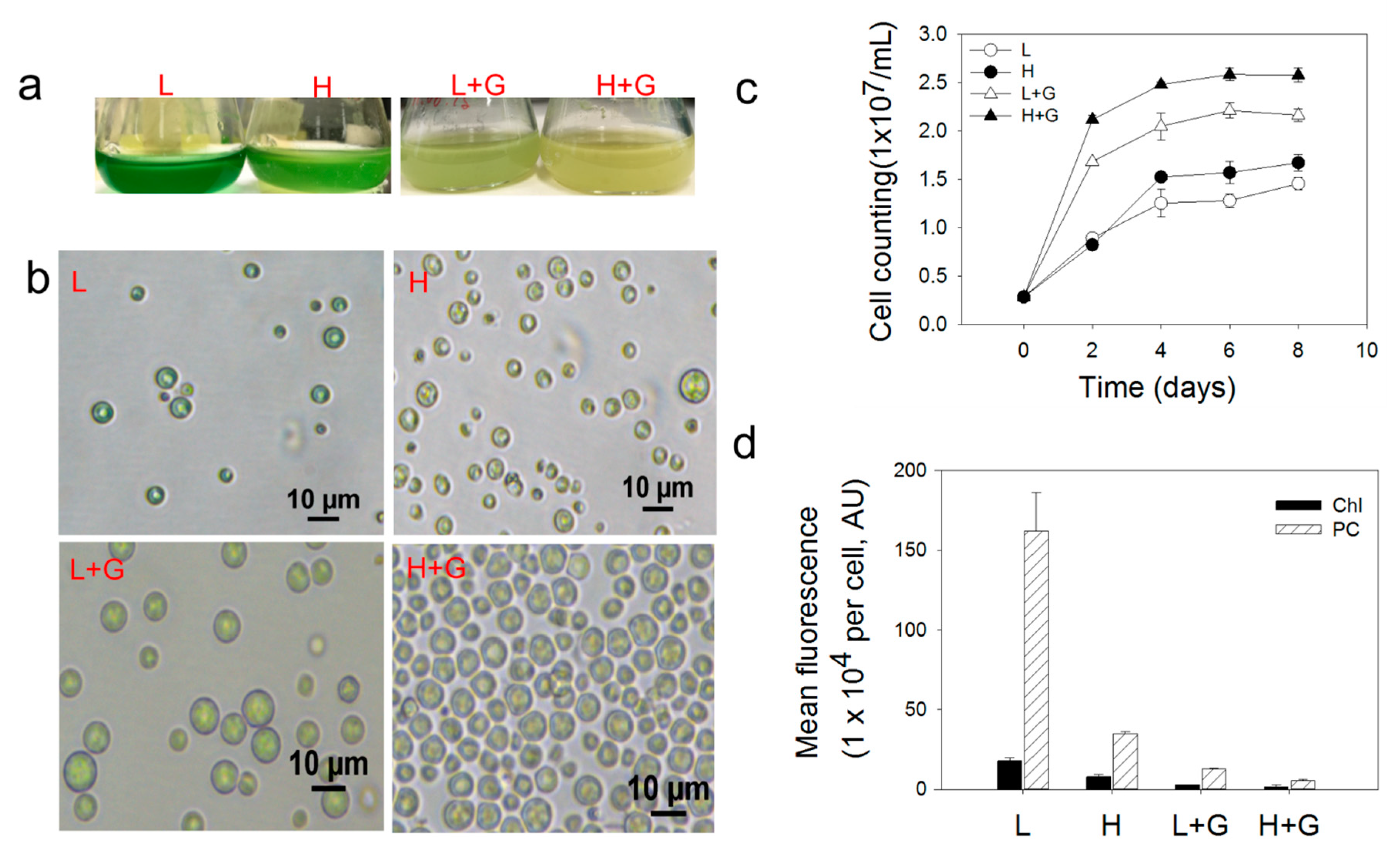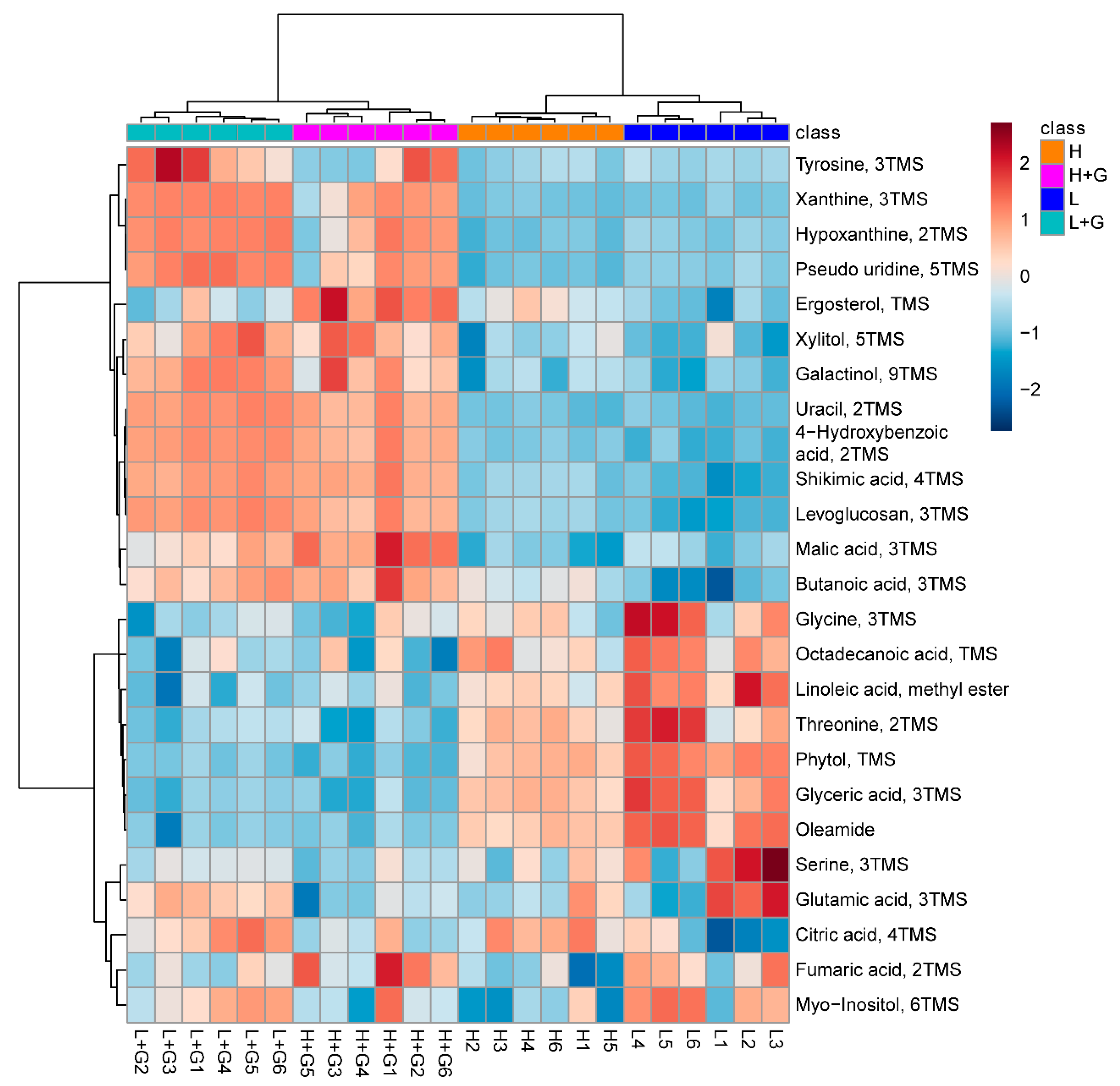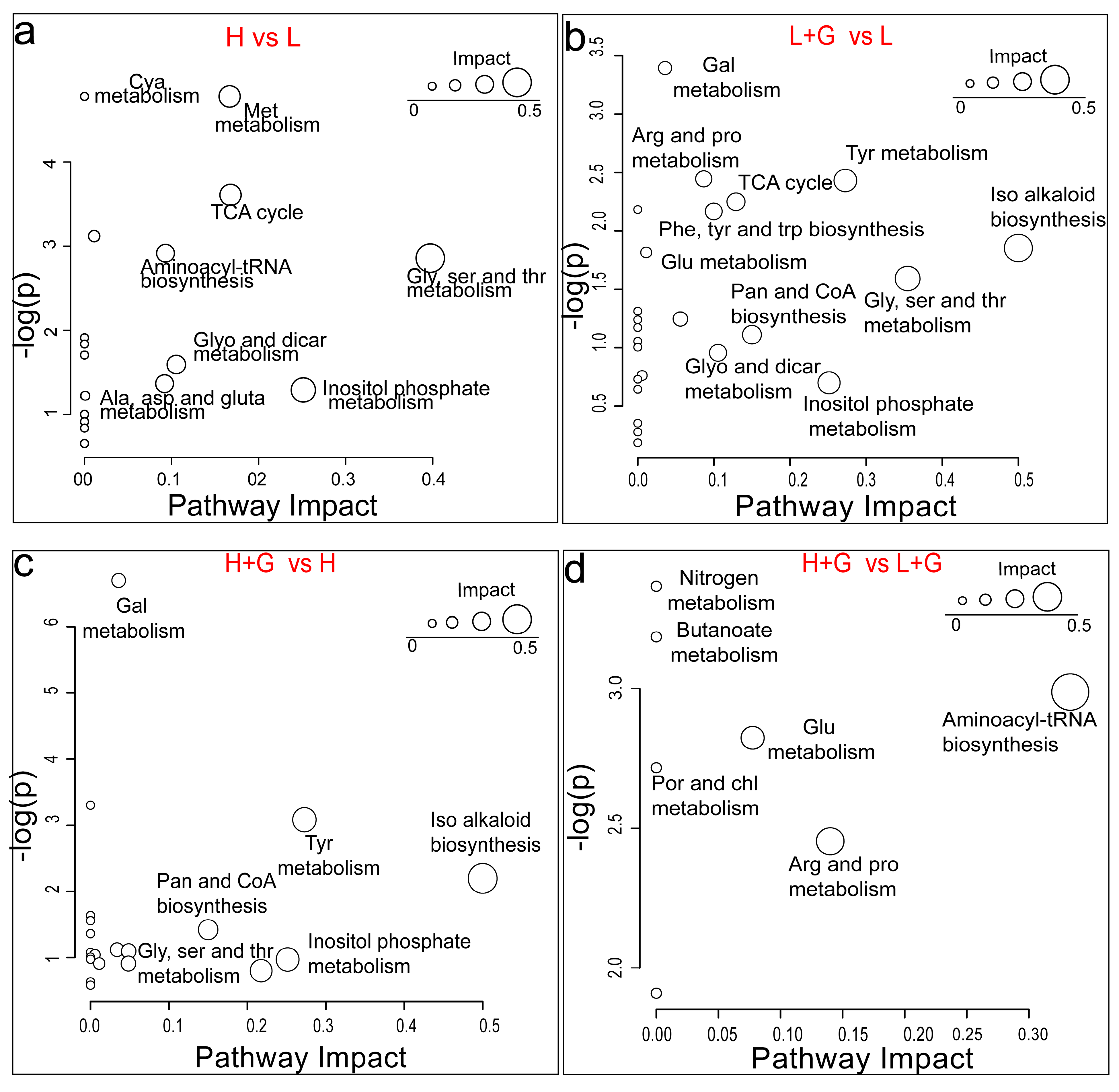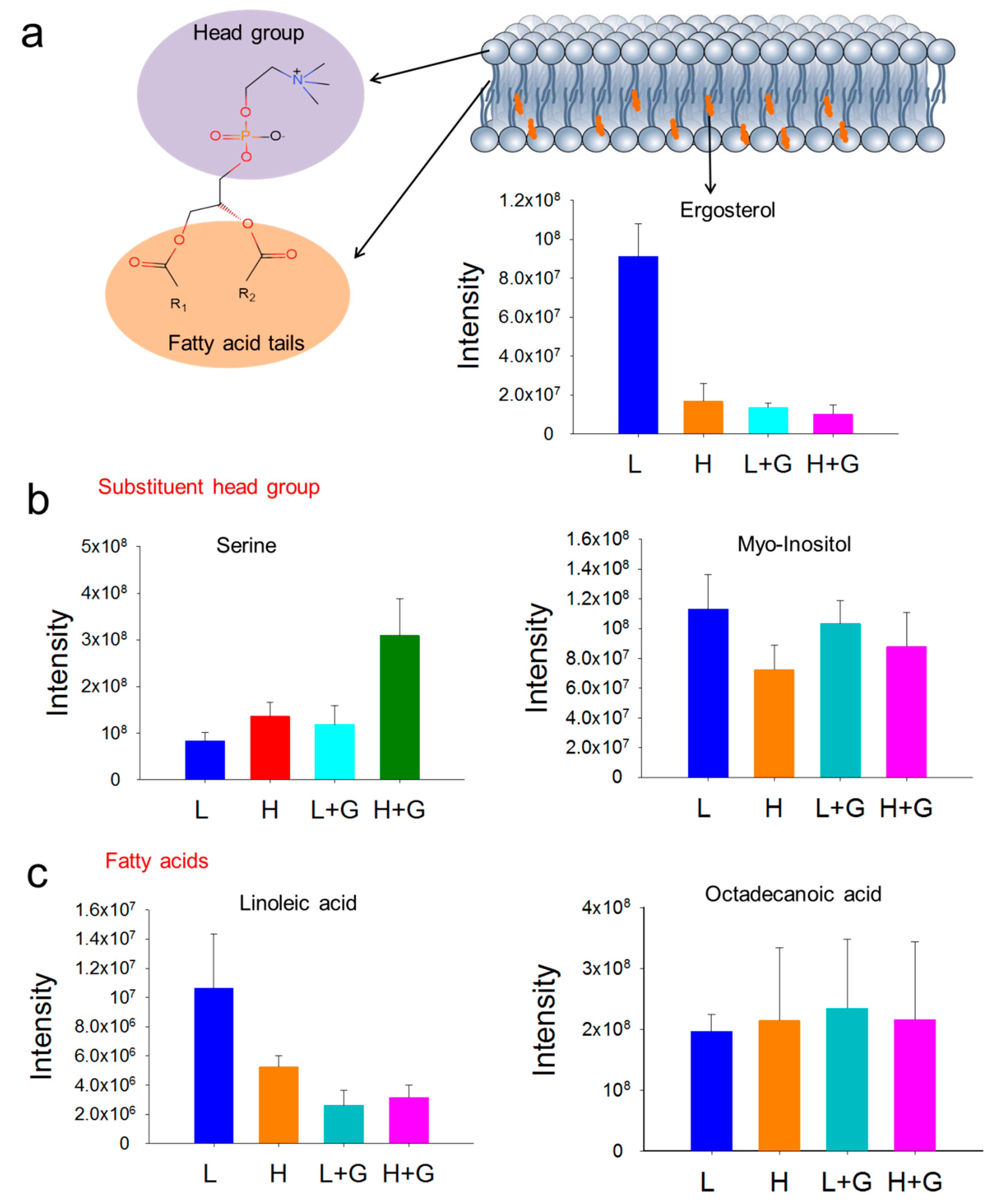Untargeted Metabolomics Unveil Changes in Autotrophic and Mixotrophic Galdieria sulphuraria Exposed to High-Light Intensity
Abstract
1. Introduction
2. Results
2.1. Physiological Status
2.2. GC–MS Endo-Metabolic Profiles
2.3. LC–MS Endo-Metabolic Profiles
2.4. Metabolic Pathway Analysis
3. Discussion
3.1. G. sulphuraria Modulates Membrane Lipid Composition to Cope with High-Light Intensity Stress
3.2. Light Stress Induces Changes in Amino Acid, Amine, and Amide Metabolism
3.3. Mixotrophic Environments Promote Alterations in Energy Metabolism
4. Materials and Methods
4.1. Algal Culture and Growth Conditions
4.2. Physiological Characterization
4.3. Algae Harvesting and Sample Preparation
4.4. GC–MS Data Acquisition
4.5. LC–MS Data Adquisition
4.6. Data Analysis
5. Conclusions
Supplementary Materials
Author Contributions
Funding
Institutional Review Board Statement
Informed Consent Statement
Data Availability Statement
Conflicts of Interest
References
- Elleuche, S.; Schafers, C.; Blank, S.; Schroder, C.; Antranikian, G. Exploration of extremophiles for high temperature biotechnological processes. Curr. Opin. Microbiol. 2015, 25, 113–119. [Google Scholar] [CrossRef]
- Varshney, P.; Mikulic, P.; Vonshak, A.; Beardall, J.; Wangikar, P.P. Extremophilic micro-algae and their potential contribution in biotechnology. Bioresour. Technol. 2015, 184, 363–372. [Google Scholar] [CrossRef]
- Minoda, A.; Sawada, H.; Suzuki, S.; Miyashita, S.; Inagaki, K.; Yamamoto, T.; Tsuzuki, M. Recovery of rare earth elements from the sulfothermophilic red alga Galdieria sulphuraria using aqueous acid. Appl. Microbiol. Biotechnol. 2015, 99, 1513–1519. [Google Scholar] [CrossRef]
- Vítová, M.; Goecke, F.; Sigler, K.; Řezanka, T. Lipidomic analysis of the extremophilic red alga Galdieria sulphuraria in response to changes in pH. Algal Res. 2016, 13, 218–226. [Google Scholar] [CrossRef]
- Thammavongs, B.; Denou, E.; Missous, G.; Gueguen, M.; Panoff, J.M. Response to environmental stress as a global phenomenon in biology: The example of microorganisms. Microbes Environ. 2008, 23, 20–23. [Google Scholar] [CrossRef] [PubMed]
- Esteves, A.M.; Graca, G.; Peyriga, L.; Torcato, I.M.; Borges, N.; Portais, J.C.; Santos, H. Combined transcriptomics-metabolomics profiling of the heat shock response in the hyperthermophilic archaeon Pyrococcus furiosus. Extremophiles 2019, 23, 101–118. [Google Scholar] [CrossRef] [PubMed]
- Kumari, A.; Das, P.; Parida, A.K.; Agarwal, P.K. Proteomics, metabolomics, and ionomics perspectives of salinity tolerance in halophytes. Front. Plant Sci. 2015, 6, 537. [Google Scholar] [CrossRef] [PubMed]
- Lutz, S.; Anesio, A.M.; Field, K.; Benning, L.G. Integrated ‘Omics’, Targeted Metabolite and Single-cell Analyses of Arctic Snow Algae Functionality and Adaptability. Front. Microbiol. 2015, 6, 1323. [Google Scholar] [CrossRef]
- Lu, N.; Chen, J.H.; Wei, D.; Chen, F.; Chen, G. Global Metabolic Regulation of the Snow Alga Chlamydomonas nivalis in Response to Nitrate or Phosphate Deprivation by a Metabolome Profile Analysis. Int. J. Mol. Sci. 2016, 17, 694. [Google Scholar] [CrossRef]
- Thangaraj, B.; Jolley, C.C.; Sarrou, I.; Bultema, J.B.; Greyslak, J.; Whitelegge, J.P.; Lin, S.; Kouril, R.; Subramanyam, R.; Boekema, E.J.; et al. Efficient light harvesting in a dark, hot, acidic environment: The structure and function of PSI-LHCI from Galdieria sulphuraria. Biophys. J. 2011, 100, 135–143. [Google Scholar] [CrossRef][Green Version]
- Yeh, K.-L.; Chang, J.-S.; Chen, W.-M. Effect of light supply and carbon source on cell growth and cellular composition of a newly isolated microalga Chlorella vulgaris ESP-31. Eng. Life Sci. 2010, 10, 201–208. [Google Scholar] [CrossRef]
- Kong, F.; Romero, I.T.; Warakanont, J.; Li-Beisson, Y. Lipid catabolism in microalgae. New Phytol. 2018, 218, 1340–1348. [Google Scholar] [CrossRef] [PubMed]
- Hannan, M.A.; Sohag, A.A.M.; Dash, R.; Haque, M.N.; Mohibbullah, M.; Oktaviani, D.F.; Hossain, M.T.; Choi, H.J.; Moon, I.S. Phytosterols of marine algae: Insights into the potential health benefits and molecular pharmacology. Phytomedicine 2020, 69, 153201. [Google Scholar] [CrossRef] [PubMed]
- Bouvier-Nave, P.; Berna, A.; Noiriel, A.; Compagnon, V.; Carlsson, A.S.; Banas, A.; Stymne, S.; Schaller, H. Involvement of the phospholipid sterol acyltransferase1 in plant sterol homeostasis and leaf senescence. Plant Physiol. 2010, 152, 107–119. [Google Scholar] [CrossRef] [PubMed]
- Lopes, G.; Sousa, C.; Bernardo, J.; Andrade, P.B.; Valentao, P.; Ferreres, F.; Mouga, T. Sterol Profiles in 18 Macroalgae of the Portuguese Coast. J. Phycol. 2011, 47, 1210–1218. [Google Scholar] [CrossRef]
- Villain, J.; Minguez, L.; Halm-Lemeille, M.P.; Durrieu, G.; Bureau, R. Acute toxicities of pharmaceuticals toward green algae. mode of action, biopharmaceutical drug disposition classification system and quantile regression models. Ecotoxicol. Environ. Saf. 2016, 124, 337–343. [Google Scholar] [CrossRef]
- Ikekawa, N.; Morisaki, N.; Tsuda, K.; Yoshida, T. Sterol compositions in some green algae and brown algae. Steroids 1968, 12, 41–48. [Google Scholar] [CrossRef]
- Caroprese, M.; Albenzio, M.; Ciliberti, M.G.; Francavilla, M.; Sevi, A. A mixture of phytosterols from Dunaliella tertiolecta affects proliferation of peripheral blood mononuclear cells and cytokine production in sheep. Vet. Immunol. Immunopathol. 2012, 150, 27–35. [Google Scholar] [CrossRef]
- Bastos, A.E.P.; Marinho, H.S.; Cordeiro, A.M.; Soure, A.M.D.; Almeida, R.F.M.D. Biophysical properties of ergosterol-enriched lipid rafts in yeast and tools for their study: Characterization of ergosterol/phosphatidylcholine membranes with three fluorescent membrane probes. Chem. Phys. Lipids 2012, 165, 577–588. [Google Scholar] [CrossRef]
- de Kroon, A.I.; Rijken, P.J.; De Smet, C.H. Checks and balances in membrane phospholipid class and acyl chain homeostasis, the yeast perspective. Prog. Lipid Res. 2013, 52, 374–394. [Google Scholar] [CrossRef]
- Vijayakumar, V.; Liebisch, G.; Buer, B.; Xue, L.; Gerlach, N.; Blau, S.; Schmitz, J.; Bucher, M. Integrated multi-omics analysis supports role of lysophosphatidylcholine and related glycerophospholipids in the Lotus japonicus-Glomus intraradices mycorrhizal symbiosis. Plant Cell Environ. 2016, 39, 393–415. [Google Scholar] [CrossRef] [PubMed]
- Gao, W.; Li, H.Y.; Xiao, S.; Chye, M.L. Acyl-CoA-binding protein 2 binds lysophospholipase 2 and lysoPC to promote tolerance to cadmium-induced oxidative stress in transgenic Arabidopsis. Plant J. 2010, 62, 989–1003. [Google Scholar] [CrossRef] [PubMed]
- You, Z.; Zhang, Q.; Peng, Z.; Miao, X. Lipid Droplets Mediate Salt Stress Tolerance in Parachlorella kessleri. Plant Physiol. 2019, 181, 510–526. [Google Scholar] [CrossRef] [PubMed]
- Monteiro, J.P.; Rey, F.; Melo, T.; Moreira, A.S.P.; Arbona, J.F.; Skjermo, J.; Forbord, S.; Funderud, J.; Raposo, D.; Kerrison, P.D.; et al. The Unique Lipidomic Signatures of Saccharina latissima Can Be Used to Pinpoint Their Geographic Origin. Biomolecules 2020, 10, 107. [Google Scholar] [CrossRef] [PubMed]
- Li, L.; Aro, E.M.; Millar, A.H. Mechanisms of photodamage and protein turnover in photoinhibition. Trends Plant Sci. 2018, 23, 667–676. [Google Scholar] [CrossRef]
- Kana, R.; Kotabova, E.; Lukes, M.; Papacek, S.; Matonoha, C.; Liu, L.N.; Prasil, O.; Mullineaux, C.W. Phycobilisome mobility and its role in the regulation of light harvesting in red algae. Plant Physiol. 2014, 165, 1618–1631. [Google Scholar] [CrossRef]
- Davis, M.C.; Fiehn, O.; Durnford, D.G. Metabolic acclimation to excess light intensity in Chlamydomonas reinhardtii. Plant Cell Environ. 2013, 36, 1391–1405. [Google Scholar] [CrossRef]
- Hildebrandt, T.M.; Nunes Nesi, A.; Araujo, W.L.; Braun, H.P. Amino Acid Catabolism in Plants. Mol. Plant 2015, 8, 1563–1579. [Google Scholar] [CrossRef]
- Impa, S.M.; Sunoj, V.S.J.; Krassovskaya, I.; Bheemanahalli, R.; Obata, T.; Jagadish, S.V.K. Carbon balance and source-sink metabolic changes in winter wheat exposed to high night-time temperature. Plant Cell Environ. 2019, 42, 1233–1246. [Google Scholar] [CrossRef]
- Del Duca, S.; Serafini-Fracassini, D.; Cai, G. Senescence and programmed cell death in plants: Polyamine action mediated by transglutaminase. Front. Plant Sci. 2014, 5, 120. [Google Scholar] [CrossRef]
- Navakoudis, E.; Vrentzou, K.; Kotzabasis, K. A polyamine- and LHCII protease activity-based mechanism regulates the plasticity and adaptation status of the photosynthetic apparatus. Biochim. Biophys. Acta 2007, 1767, 261–271. [Google Scholar] [CrossRef] [PubMed]
- Hartmann, A.; Albert, A.; Ganzera, M. Effects of elevated ultraviolet radiation on primary metabolites in selected alpine algae and cyanobacteria. J. Photochem. Photobiol. B Biol. 2015, 149, 149–155. [Google Scholar] [CrossRef] [PubMed][Green Version]
- Navakoudis, E.; Lütz, C.; Langebartels, C.; Luetz-Meindl, U.; Kotzabasis, K. Ozone impact on the photosynthetic apparatus and the protective role of polyamines. Biochim. Biophys. Acta BBA Gen. Subj. 2003, 1621, 160–169. [Google Scholar] [CrossRef]
- Berglund, T.; Kalbin, G.; Strid, Å.; Rydström, J.; Ohlsson, A.B. UV-B- and oxidative stress-induced increase in nicotinamide and trigonelline and inhibition of defensive metabolism induction by poly(ADP-ribose)polymerase inhibitor in plant tissue. FEBS Lett. 1996, 380, 188–193. [Google Scholar] [CrossRef]
- Zhan, J.; Rong, J.; Wang, Q. Mixotrophic cultivation, a preferable microalgae cultivation mode for biomass/bioenergy production, and bioremediation, advances and prospect. Int. J. Hydrogen Energy 2017, 42, 8505–8517. [Google Scholar] [CrossRef]
- Ju, X.H.; Igarashi, K.; Miyashita, S.; Mitsuhashi, H.; Inagaki, K.; Fujii, S.; Sawadaa, H.; Kuwabaraa, T.; Minodaa, A. Effective and selective recovery of gold and palladium ions from metal wastewater using a sulfothermophilic red alga, Galdieria sulphuraria. Bioresour. Technol. 2016, 211, 759–764. [Google Scholar] [CrossRef]
- Sarian, F.D.; Rahman, D.Y.; Schepers, O.; van der Maarel, M.J. Effects of oxygen limitation on the biosynthesis of photo pigments in the red microalgae Galdieria sulphuraria strain 074G. PLoS ONE 2016, 11, e0148358. [Google Scholar] [CrossRef]
- Catalanotti, C.; Yang, W.; Posewitz, M.C.; Grossman, A.R. Fermentation metabolism and its evolution in algae. Front. Plant Sci. 2013, 4, 150. [Google Scholar] [CrossRef]
- Ashihara, H.; Stasolla, C.; Fujimura, T.; Crozier, A. Purine salvage in plants. Phytochemistry 2018, 147, 89–124. [Google Scholar] [CrossRef]
- Tohge, T.; Watanabe, M.; Hoefgen, R.; Fernie, A.R. Shikimate and phenylalanine biosynthesis in the green lineage. Front. Plant Sci. 2013, 4, 62. [Google Scholar] [CrossRef]
- Corea, O.R.; Ki, C.; Cardenas, C.L.; Kim, S.J.; Brewer, S.E.; Patten, A.M.; Davin, L.B.; Lewis, N.G. Arogenate dehydratase isoenzymes profoundly and differentially modulate carbon flux into lignins. J. Biol. Chem. 2012, 287, 11446–11459. [Google Scholar] [CrossRef] [PubMed]
- Hill, C.B.; Jha, D.; Bacic, A.; Tester, M.; Roessner, U. Characterization of ion contents and metabolic responses to salt stress of different Arabidopsis AtHKT1;1 genotypes and their parental strains. Mol. Plant 2013, 6, 350–368. [Google Scholar] [CrossRef] [PubMed]
- Gustavs, L.; Eggert, A.; Michalik, D.; Karsten, U. Physiological and biochemical responses of green microalgae from different habitats to osmotic and matric stress. Protoplasma 2010, 243, 3–14. [Google Scholar] [CrossRef] [PubMed]
- Ayako, N.; Yukinori, Y.; Shigeru, S. Galactinol and raffinose constitute a novel function to protect plants from oxidative damage. Plant Physiol. 2008, 147, 1251–1263. [Google Scholar]
- Hirth, M.; Liverani, S.; Mahlow, S.; Bouget, F.Y.; Pohnert, G.; Sasso, S. Metabolic profiling identifies trehalose as an abundant and diurnally fluctuating metabolite in the microalga Ostreococcus tauri. Metabolomics 2017, 13, 68. [Google Scholar] [CrossRef] [PubMed]
- XCMS. Available online: https://xcmsonline.scripps.edu/landing_page.php?pgcontent=viewResults (accessed on 9 October 2020).
- CAMERA. Available online: https://bioconductor.org/packages/CAMERA/ (accessed on 20 October 2020).
- Xia, J.; Psychogios, N.; Young, N.; Wishart, D.S. MetaboAnalyst: A web server for metabolomic data analysis and interpretation. Nucleic Acids Res. 2009, 37, W652–W660. [Google Scholar] [CrossRef]
- SIRIUS. Available online: https://bio.informatik.uni-jena.de/software/sirius/ (accessed on 12 October 2020).
- CFM-ID. Available online: https://cfmid.wishartlab.com/ (accessed on 12 October 2020).
- MetFrag. Available online: https://msbi.ipb-halle.de/MetFrag/ (accessed on 12 October 2020).
- mzCloud. Available online: https://www.mzcloud.org/ (accessed on 12 October 2020).
- LipidBank. Available online: https://lipidbank.jp/ (accessed on 12 October 2020).
- The Kyoto Encyclopedia of Genes and Genomes Pathway Database. Available online: https://www.genome.ad.jp/kegg/pathway.html (accessed on 15 October 2020).





| Comparison | No. | ESI Mode | Putative Compound | Main Class | Formula | Precursor m/z | RT (min) | PCA Loading (PC1) | VIP | p-Value | log2 (FC) | Modulation Trend | Identification Level (Blaženovi´c, Kind, Ji, & Fiehn, 2018) |
|---|---|---|---|---|---|---|---|---|---|---|---|---|---|
| H vs. L | 1 | + | LysoPC (18:3) | Lysophospha-tidylcholine | C26H48NO7P | 518.3235 | 6.30 | −0.068395 | 1.043 | 1.17 × 10−5 | 2.1196 | up | Level 1 |
| 2 | + | LysoPC (18:2) | Lysophospha-tidylcholine | C26H50NO7P | 520.3389 | 6.65 | −0.30333 | 4.2546 | 2.5 × 10−4 | 2.5346 | up | Level 1 | |
| 3 | + | LysoPC (18:1) | Glycerophos-phocholine | C26H52NO7P | 522.3551 | 7.44 | −0.24913 | 4.0773 | 8.18 × 10−4 | 2.3811 | up | Level 1 | |
| 4 | + | PC (18:1/20:6) | Glycerophos-phocholine | C46H79NO8P | 804.5494 | 7.61 | −0.29671 | 3.5255 | 1.89 × 10−4 | 2.161 | up | Level 1 | |
| 5 | + | unknow | unknow | C29H41ClN4O8 | 631.2508 | 8.77 | 0.18704 | 1.0907 | 7.55 × 10−4 | −2.179 | down | Level 2 | |
| 6 | + | unknow | unknow | C33H36N6O8 | 645.265 | 9.38 | 0.15828 | 2.2146 | 1.0307 × 10−2 | −1.9636 | down | Level 2 | |
| 7 | + | PI (22:6/22:4) | Glycerophos-phoinositols | C53H83O13P | 959.566 | 10.31 | −0.25491 | 1.1747 | 2.24 × 10−4 | −1.2848 | down | Level 1 | |
| L + G vs. L | 1 | + | LysoPC (18:3) | Lysophospha-tidylcholine | C26H48NO7P | 518.3235 | 6.30 | 0.070117 | 1.1649 | 8.0053 × 10−9 | 4.3014 | up | Level 1 |
| 2 | + | PC (18:2/20:6) | Phosphatidyl- choline | C46H77NO8P | 802.4861 | 6.80 | 0.056888 | 1.0338 | 2.07 × 10−4 | 2.2225 | up | Level 1 | |
| 3 | + | DL-tryptophyl-DL- asparagyl-DL-tyrosyl-DL-tyrosine | Unknow Peptide | C33H36N6O8 | 645.2656 | 9.40 | −0.064178 | 1.131 | 1.3 × 10−6 | −5.4394 | down | Level 1, Level 1 | |
| 4 | + | DL-tryptophyl-DL-asparagyl-DL-tyrosyl-DL-phenylalanine | Unknow Peptide | C33H36N6O7 | 629.2705 | 9.66 | −0.070266 | 1.1715 | 9.62 × 10−10 | −7.5637 | down | Level 1 | |
| 5 | + | methyl 3-[(4Z,15Z)-12-acetyl-3,8,13,17-tetramethyl-18-(3-methylperoxypropyl)-6,10,14,20-tetrahydroporphyrin-2-yl]propanoate | Porphyrin Derivatives | C34H40N4O5 | 607.2892 | 9.78 | −0.06728 | 1.122 | 2.792 × 10−6 | −4.2453 | down | Level 1 | |
| 6 | + | PI(22:6/22:4) | Glycerophosphoinositols | C53H83O13P | 959.566 | 10.31 | −0.070604 | 1.0771 | 4.03 × 10−5 | −1.7165 | down | Level 1 | |
| 7 | − | LysoPE (18:2) | Lysophosphatidylethanolamine | C23H44NO7P | 476.2786 | 6.47 | 0.02547 | 1.1401 | 6.435 × 10−3 | −2.2383 | down | Level 1 | |
| H + G vs. H | 1 | + | [2-hydroxy-3-[(7~[1])-2-methoxy-12-methyloctadeca-7,17-dien-5-ynoyl]oxypropyl] 2-(trimethylazaniumyl)ethyl phosphate | Lysophosphatidylcholines | C28H50NO8P | 560.3346 | 4.81 | −0.077822 | 1.1378 | 1.78 × 10−4 | −1.6521 | down | Level 1 |
| 2 | + | (2~[2],3~{S})-2-amino-3-[hydroxy-[(2~{R})-2-hydroxy-3-[(~{E})-2-oxononadec-10-enoyl]oxypropoxy]phosphoryl]oxybutanoic acid | Lysophosphatidylcholines | C26H48NO10P | 566.3092 | 4.88 | −0.086237 | 1.2197 | 2.24 × 10−6 | −2.5654 | down | Level 1 | |
| 3 | + | 4-[[(2~{S},3~{S},5~{R})-5-[6-(diphenylcarbamoyloxy)-2-(2-methylpropanoylamino)purin-9-yl]-3-(tritylamino)oxolan-2-yl]methoxy]-4-oxobutanoic acid | unknown | C50H47N7O8 | 874.3572 | 4.98 | −0.033832 | 1.186 | 2.35 × 10−5 | −2.4192 | down | Level 1 | |
| 4 | + | 1,1-dicyclohexyl-3-[5-[[(1-ethylsulfonylpyrrolidin-3-yl)amino]methyl]-1,3-thiazol-2-yl]urea | unknown | C23H39N5O3S2 | 498.2573 | 6.04 | −0.14908 | 1.2502 | 2.49 × 10−8 | −4.7897 | down | Level 1 | |
| 5 | + | LysoPC (18:1) | Phosphatidylcholine | C26H52NO7P | 522.3551 | 7.44 | −0.018656 | 1.0573 | 1.418 × 10−3 | −2.6821 | down | Level 1 | |
| 6 | + | methyl 3-[(4Z,15Z)-12-acetyl-3,8,13,17-tetramethyl-18-(3-methylperoxypropyl)-6,10,14,20-tetrahydroporphyrin-2-yl]propanoate | Porphyrin Derivatives | C34H40N4O5 | 607.2892 | 9.78 | −0.044436 | 1.243 | 1.16 × 10−7 | −3.1398 | down | Level 1 | |
| 7 | + | PI (22:6/22:4) | Glycerophosphoinositols | C53H83O13P | 959.566 | 10.31 | −0.08073 | 1.1664 | 6.03 × 10−5 | −2.0112 | down | Level 1 | |
| 8 | − | LysoPC (18:3) | Lysophosphatidylcholine | C26H48NO7P | 562.3165 | 6.3 | 0.028007 | 1.0263 | 1.0308 × 10−2 | 1.1963 | up | Level 1 | |
| 9 | − | unknown | unknown | unknown | 547.277 | 6.91 | −0.10462 | 1.0438 | 8.562 × 10−3 | −1.6929 | down | Level 2 | |
| 10 | − | 2-Lysophosphatidylcholine | Glycerophosphates | C26H54NO7P | 566.3478 | 7.68 | −0.09984 | 1.072 | 6.215 × 10−3 | −1.8005 | down | Level 1 | |
| 11 | − | Methyl phaeophorbide PubChem CID:136857430 | Porphyrin Derivatives | C36H38N4O5 | 605.2775 | 9.65 | −0.070852 | 1.1764 | 1.435 × 10−3 | −3.4996 | down | Level 1 | |
| 12 | − | unknown | unknown | C48H84N6O10S | 935.5877 | 10.3 | −0.095787 | 1.2273 | 5.54 × 10−4 | −2.0954 | down | Level 1 | |
| H + G vs. L + G | 1 | + | LysoPC (18:3) | Lysophosphatidylcholine | C26H48NO7P | 518.3235 | 6.3 | 0.079268 | 1.0215 | 1.1551 × 10−2 | −1.1442 | down | Level 1 |
| 2 | + | LysoPC (18:2) | Lysophosphatidylcholine | C26H50NO7P | 520.3389 | 6.65 | 0.040487 | 1.2975 | 7.0637 × 10−3 | −1.1345 | down | Level 1 | |
| 3 | + | PC (18:2/20:6) | Glycerophosphocholines | C46H77NO8P | 802.4861 | 6.8 | 0.085526 | 1.1794 | 5.162 × 10−3 | −0.49963 | down | Level 1 | |
| 4 | + | LysoPE (18:1) | Lysophosphatidylethanolamine | C23H46NO7P | 480.3072 | 7.05 | 0.1797 | 1.3815 | 7.45 × 10−4 | −1.1677 | down | Level 1 | |
| 5 | + | LysoPC (18:1) | Glycerophosphocholines | C26H52NO7P | 522.3551 | 7.44 | 0.05666 | 1.2869 | 8.69 × 10−4 | −0.85099 | down | Level 1 | |
| 6 | + | PC (18:1/20:6) | Glycerophosphocholines | C46H79NO8P | 804.5494 | 7.61 | 0.086884 | 1.2142 | 1.1944 × 10−2 | −2.0855 | down | Level 1 | |
| 7 | + | PI (22:6/22:4) | Glycerophosphoinositols | C53H83O13P | 959.566 | 10.31 | 0.0707 | 1.4764 | 1.72 × 10−3 | −0.76443 | down | Level 1 | |
| 8 | − | LysoPE (18:2) | Lysophosphatidylethanolamine | C23H44NO7P | 476.2786 | 6.47 | 0.083257 | 1.054 | 1.0469 × 10−2 | −0.79701 | down | Level 1 | |
| 9 | − | LysoPC (18:0) | Lysophosphatidylcholines | C26H54NO7P | 566.3478 | 7.68 | 0.19846 | 2.6751 | 1.0173 × 10−2 | −1.3039 | down | Level 1 |
Publisher’s Note: MDPI stays neutral with regard to jurisdictional claims in published maps and institutional affiliations. |
© 2021 by the authors. Licensee MDPI, Basel, Switzerland. This article is an open access article distributed under the terms and conditions of the Creative Commons Attribution (CC BY) license (http://creativecommons.org/licenses/by/4.0/).
Share and Cite
Liu, L.; Sanchez-Arcos, C.; Pohnert, G.; Wei, D. Untargeted Metabolomics Unveil Changes in Autotrophic and Mixotrophic Galdieria sulphuraria Exposed to High-Light Intensity. Int. J. Mol. Sci. 2021, 22, 1247. https://doi.org/10.3390/ijms22031247
Liu L, Sanchez-Arcos C, Pohnert G, Wei D. Untargeted Metabolomics Unveil Changes in Autotrophic and Mixotrophic Galdieria sulphuraria Exposed to High-Light Intensity. International Journal of Molecular Sciences. 2021; 22(3):1247. https://doi.org/10.3390/ijms22031247
Chicago/Turabian StyleLiu, Lu, Carlos Sanchez-Arcos, Georg Pohnert, and Dong Wei. 2021. "Untargeted Metabolomics Unveil Changes in Autotrophic and Mixotrophic Galdieria sulphuraria Exposed to High-Light Intensity" International Journal of Molecular Sciences 22, no. 3: 1247. https://doi.org/10.3390/ijms22031247
APA StyleLiu, L., Sanchez-Arcos, C., Pohnert, G., & Wei, D. (2021). Untargeted Metabolomics Unveil Changes in Autotrophic and Mixotrophic Galdieria sulphuraria Exposed to High-Light Intensity. International Journal of Molecular Sciences, 22(3), 1247. https://doi.org/10.3390/ijms22031247





